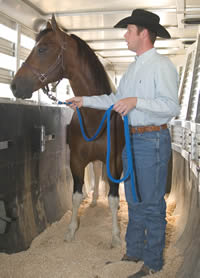
In the May 2006 issue of Horse & Rider, Bob Avila talked about the importance of basic horse care. No athlete can reach his full potential if he’s not receiving proper nutrition and health care, and your horse is no different. Here’s what every horse needs to be happy, healthy and at the top of his game:
High quality, plentiful hay: He should be getting at least 1 1/2 to 2 percent of his body weight per day in good quality hay (1,100 lb. horse = 16 1/2 to 22 pounds of hay). Check the hay for mold, bugs, droppings and foreign objects.
Water: Make sure your horse has unlimited clean water available at all times.
Salt: Give your horse free access. Plain, loose salt is better than mineralized salt blocks because he can consume more with less effort.
Minerals: In addition to offering plain, loose salt, offer your horse a mineral block.
Dental care: Schedule annual check-ups with an equine dentist or vet specializing in dental care. If he’s 15 or older, schedule a check-up every 6 to 8 months.
Parasite control: Work with your vet to check your horse’s fecal egg counts and determine a good deworming program.
Clean air: Open doors and windows for ventilation and keep dust to a minimum. Minimize ammonia odor by cleaning out urine spots and invest in an ammonia-neutralizing stall freshener if ammonia fumes are strong.
Turnout: Give your horse as much turnout time as possible; it’ll give his lungs a break from dust and ammonia, keep his joints health and minimize boredom-induced behavioral problems.
Freedom from flies: Take measures to control flies and other pesky insects by using fly predators, fly traps, sprays and feedthroughs (for more information, see “Buzz Busters,” April 2006 Horse & Rider and How to Identify, Control Pesky Flies).
Healthy pastures: Don’t allow horses to overgraze. Walk the fenceline to make sure it’s secure and take weekly strolls to check for debris. Rid your pasture of toxic plants, and check along fences to make sure neighboring trees and shrubs aren’t within reach of long-necked nibblers.
Good grooming: Not only does it promote a healthy hair coat, it gives you a chance to bond with your horse and keeps you on top of skin problems, problem spots and potential injuries.
An educated owner: Make a list of horse care and training articles and books you want to read, and bookmark Internet sites like EquiSearch.com that offer horse care information.
Excerpted from “Take Charge,” a November 2001 Horse & Rider article.






